Whether you’re just visiting or planning to live in Portugal, learning some food vocabulary is going to be pretty important! 😆 As part of our Cooking and Eating unit, this guide should give you a good introduction to dining out in Portugal, or, in other words: comer foragoing out to eat
Breakfast & Coffee
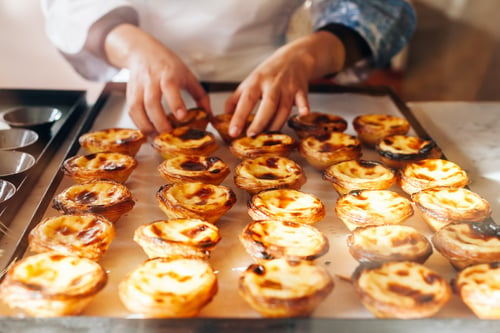 There are caféscafés, coffee shops and pastelariasbakeries , which are often part of the same establishment, for snacks and light meals. This is where you’ll go for um pequeno-almoçoa breakfast or um lanchea snack
There are caféscafés, coffee shops and pastelariasbakeries , which are often part of the same establishment, for snacks and light meals. This is where you’ll go for um pequeno-almoçoa breakfast or um lanchea snack
Perhaps you’ll ask for um caféa coffee and the world-famous pastel de natacustard tart . A pastel is usually a small tart or cake, which can be sweet, like the pastel de nata, or savoury, like the o pastel de bacalhaucodfish cake . You’ll find a wide variety of delicious options to order at the pastelaria.
Unfortunately for those who like protein-rich breakfasts, it’s less common to find os ovoseggs on the traditional Portuguese breakfast menu, though they do appear in a number of dishes served later in the day.
There are many different typical coffee beverages in Portugal. If you just order um caféa coffee you will receive an espresso, unless you specify otherwise. Some of the other most common options are:
- um galão – Contains more milk than coffee, served in a tall glass
- uma meia de leite – A cup containing half milk and half coffee
- um abatanado – This is the Portuguese equivalent of an americano, which is espresso with extra water. At most cafés, this is the closest you will get to a full cup of drip coffee. If you want it with milk, ask for um abatanado pingadoan americano with a 'drop' of milk . To further complicate things, not all places in Portugal use the term abatanado, so you can also just try asking for um americano
Tip: You may get a funny look if you order coffee before a meal instead of after… or if you ask for cream (natas) with your coffee! These practices are not common in Portugal. #estrangeiroproblems
Lunch & Dinner
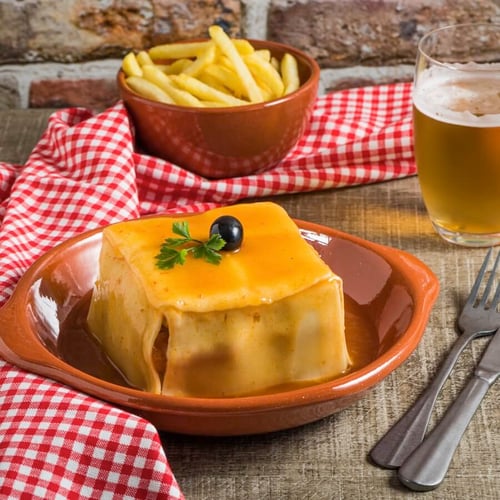 For o almoçolunch and o jantardinner , you might go out to um restaurantea restaurant , but not all locations serving these meals use that name. Some smaller establishments offering light meals (usually lunches), have the name ‘snack-bar’, functioning as a hybrid of café and restaurant. There are also cervejarias , named as such because, originally, these restaurants produced their own cervejabeer .
For o almoçolunch and o jantardinner , you might go out to um restaurantea restaurant , but not all locations serving these meals use that name. Some smaller establishments offering light meals (usually lunches), have the name ‘snack-bar’, functioning as a hybrid of café and restaurant. There are also cervejarias , named as such because, originally, these restaurants produced their own cervejabeer .
Common Menu Items
Here are a few common foods you may see on the menu when dining out in Portugal:
- pica-pau
- Small pieces of pork, marinated in either beer or white wine and fried in olive oil. Includes lots of garlic and pickles and sometimes piri-piri hot sauce. Its name translates literally to “woodpecker”, probably because you eat them with a toothpick.
- moelas
- Similar to pica-pau but made with chicken gizzard (instead of pork), plus tomato pulp and paprika.
- caracóissnails
- Snails are a popular summer dish, often eaten with a toothpick and paired with an ice-cold beer. The simplest recipe involves boiling them with garlic, bay leafs, onions and salt, and seasoning them with oregano.
- camarõesshrimp
- Typically served boiled or fried
- bife à casahouse steak
- This steak often comes with an egg on top, accompanied by rice, fries, and salad. It can include other ingredients such as ham, cheese, sausages, pickles, as well as sauces made with beer, mustard, coffee, etc.
- a francesinha
- A very famous sandwich based on a French recipe, but born in the city of Porto. Ingredients include beef, ham, various sausages, and cheese, with a fried egg on top. The most important part is the sauce, which is poured on top while extremely hot. You’ll need a fork and knife for this sandwich!
- leitãosuckling pig
- Roasted and served with either fries or potato chips, plus a spicy molho de leitão , which is made with pepper, garlic, lard, among other ingredients. It also comes in sandwich form.
As you can see, it’s not always easy being a vegetarian in Portugal!
Common Appetizers
 Whatever the choice, the entradasappetizers, starters for lunch or dinner are usually the same:
Whatever the choice, the entradasappetizers, starters for lunch or dinner are usually the same:
- um cesto de pãoa basket of bread
- It can be just white bread or include other varieties such as tostastoasts and broa de milhocorn bread
- as azeitonasolives
- Sometimes seasoned with olive oil, garlic and oregano
- a manteigabutter
- patê de atumtuna paté or patê de sardinhasardine paté
A “finer” restaurant may also include:
- presuntoprosciutto
- Sometimes paired with melon cubes
- queijoscheeses
- Sliced cured cheeses or fresh cheese, pressed into a round shape
- rissóisrissoles
- Half-moon shaped, deep-fried pastries, commonly filled with shrimp or meat
- enchidos fumadossmoked sausages
- Could be chouriços, morcelas (similar to black pudding), alheiras or farinheiras
Wait a Minute… I Didn’t Order This!
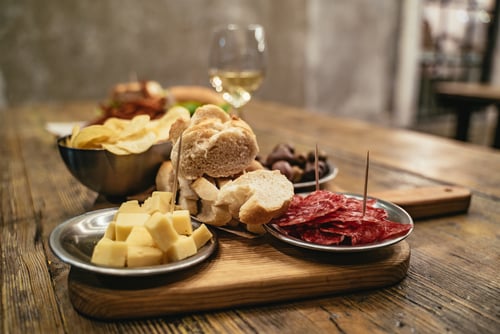 These entradas, also called aperitivosappetizers , almost always appear “automatically” on the table to snack on while waiting for your meal. However, they are optional. If you do not want to eat or pay for them, just say:
These entradas, also called aperitivosappetizers , almost always appear “automatically” on the table to snack on while waiting for your meal. However, they are optional. If you do not want to eat or pay for them, just say:
- Pode levar as entradasYou can take the appetizers or Não vamos querer entradas, obrigadoWe are not going to want appetizers, thank you
Virtually all restaurants offer pratos do diadishes of the day, daily specials . Unlike the other dishes on the menu, these are not cooked to order, so the waiting time is shorter. They may also include fresher ingredients, such as fish.
Just in case you’re on a tight schedule, keep in mind that meal time can be rather sacred for the Portuguese, as they usually like to enjoy it without rushing! However, if you’re looking to fill up on grease, you can still find fast food in some areas. The English phrase is commonly heard in Portuguese conversation, but you’ll also hear its Portuguese equivalent, comida rápidafast food .
Beverages
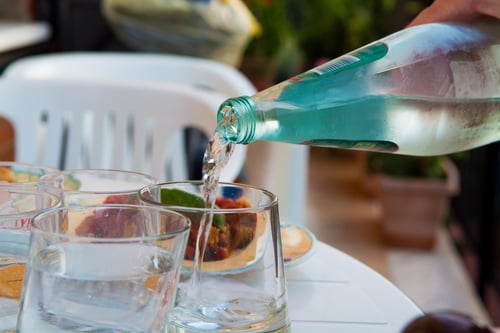 Water is not offered automatically when dining out in Portugal. You can, of course, order a bottle of water, but remember that it’s not free. You should specify how many glasses you’d like if multiple people are sharing.
Water is not offered automatically when dining out in Portugal. You can, of course, order a bottle of water, but remember that it’s not free. You should specify how many glasses you’d like if multiple people are sharing.
Your water can be com gássparkling, with gas or sem gásstill, without gas , and frescacold, cool or naturalnatural, room-temperature .
If you wish to drink wine, but you’re not sure about any of the wines on the list (or you just want a cheaper option!), you might ask for the vinho da casahouse wine . This wine is the choice of the restaurant and it’s usually a local wine, or from the region.
Payment and Tipping
 In Portugal, a contathe bill is not brought to the table automatically. Depending on the establishment, you will either pay at the front counter before leaving, or you’ll need to let your waiter or waitress know that you are ready to pay. If you are paying by card, typically they will bring the card reader to your table, rather than taking your card.
In Portugal, a contathe bill is not brought to the table automatically. Depending on the establishment, you will either pay at the front counter before leaving, or you’ll need to let your waiter or waitress know that you are ready to pay. If you are paying by card, typically they will bring the card reader to your table, rather than taking your card.
What about deixar a gorjetaleaving the tip ? Unlike what happens in various other countries, tipping a certain percentage of the cost of the meal is not expected in Portugal.
Some people don’t tip at all, while others leave 1€ or 2€ on the table before they leave. If it’s a fancier place, or if you had great service, you’re always welcome to tip more. 5-10% is more than welcome, but if you tip more than that, you’ll certainly make the staff very happy!
If you do leave a tip, you can leave any amount you’d like, but anything less than 0.50€ could be taken as an insult. In some touristy areas, tipping is becoming more expected these days, but again, it’s not mandatory.
If you want to add a tip on your card, instead of using cash, you will often need to tell your server to add that amount before they run your card:
Posso incluir a gorjeta no pagamento com cartão, por favor?Can I add a tip to the card payment, please?
That said, a few modern restaurants have the option for tip available on the card reader.
Food Shopping
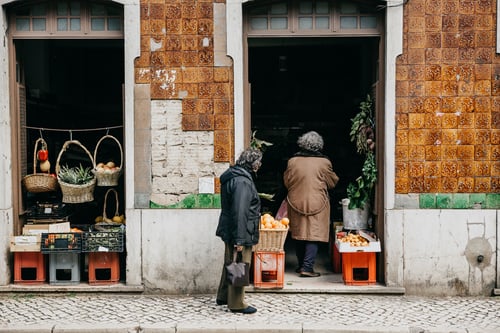 We hope that gave you a good introduction to dining out in Portugal, but we’re not ready to stop talking about food yet!
We hope that gave you a good introduction to dining out in Portugal, but we’re not ready to stop talking about food yet!
For those who prefer home-cooked meals, you can find your ingredientesingredients at merceariasgrocery stores and mercadosmarkets , which are for smaller, everyday purchases.
If you want to buy in bulk, find international products, or just have access to a wider variety and quantity of products, you can go to supermercadossupermarkets and hipermercadoshypermarkets , which are often found in larger shopping areas.
Tip: In Portugal, 24-hour convenience stores (aside from gas station shops 🤢) are not really a thing, so make sure you’ve got everything you need before the stores close (around 9:00pm, at least in Lisbon).
Differences between 🇵🇹 European and 🇧🇷 Brazilian Portuguese
If you’ve learned some Brazilian Portuguese in the past, keep in mind that there are many vocabulary differences when it comes to food. Here are a few common ones to keep in mind next time you’re shopping or dining out in Portugal:
- 🇵🇹 o pequeno-almoçobreakfast | 🇧🇷 café da manhã
- 🇵🇹 cafécafe, coffee shop | 🇧🇷 cafeteria
- 🇵🇹 o talhobutcher shop | 🇧🇷 açougue
- 🇵🇹 geladoice cream | 🇧🇷 sorvete
- 🇵🇹 sumojuice | 🇧🇷 suco
- 🇵🇹 a imperialsmall draft beer (Southern Portugal) or o finosmall draft beer (Northern Portugal) | 🇧🇷 chope
- 🇵🇹 massapasta | 🇧🇷 macarrão
- 🇵🇹 o ananáspineapple | 🇧🇷 abacaxi
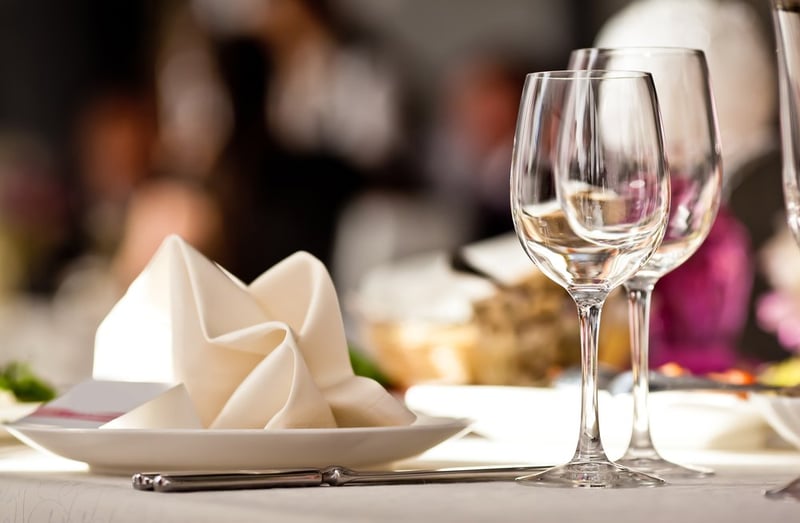


What kind of parsley is used in Portugese cozinha?
Parley is called salsa in Portuguese. Flat leaf parsley (what we would call Italian parsley in the US) is the kind sold commonly in markets here.
I’ve lived in Portugal back when I was a meat eater so all of this is very familiar, taking me right back! Now I’m vegan. Is there a section coming up about dietary choices? How to explain what you require/don’t want included? Also I’ve noticed in Portugal they get the vegetarian/vegan terms mixed up also. The terminology can be inconsistent.
I just published a blog post that might be helpful: Being a Vegetarian in Portugal It’s more geared toward vegetarians, but much of the information can apply to vegans. Let me know if there’s anything else we could add that would be useful for you!
I don’t drink alcohol and I’ve seen a lot of meat dishes common in Portugal are often marinated in wine or beer. Will it be clear on menus whether the meat served with a dish is marinated in alcohol?
Some dishes might mention wine, but I don’t think it will always be clear. You would probably have to ask to be sure. I’ll see if Joseph can respond with a good phrase for asking this. 🙂
I had always thought that the alcohol cooks out when food is heated, but I just looked it up and apparently that’s not true.
Olá, Peter. Here are some simple ways of asking:
– O prato tem álcool? (Does the dish have alcohol?)
– A receita tem álcool? (Does the recipe have alcohol?)
Or, a bit longer:
– A carne está marinada em álcool? (Is the meat marinated in alcohol?)
– O peixe está marinado em álcool? (Is the fish marinated in alcohol?)
Muito obrigado!
Are there particular “comida rápida” (fast food) chains in Portugal that are popular? I don’t mean American fast food (I’m sure you can find McDonald’s in the touristy areas) but Portuguese original chains that the locals flock to.
Olá, Peter. I can’t think of much that I would personally call fast food, but there are some well-known Portuguese chains, namely, “A Padaria Portuguesa” (literally, “The Portuguese Bakery”), which is a still-recent success story (launched in 2010), and “Portugália”, which has been a staple restaurant chain for many years. There are other names that pop up in an increasing number of food courts, such as “Sr. Frango da Guia” and “Prego Gourmet”.
A Padaria Portuguesa sounds intriguing. I’ve never met a bakery I haven’t liked… 🙂
Could you add the word for tip – gorjeta – in Payments and Tipping . Searching in Translate gives dica – a piece of advice.
Deixar uma gorjeta para o empregado/a de mesa.
Added 🙂
In the north, sometimes I get a galao even if I ask for a meia de leite. Would you say uma meia de leite direita if you want an espresso with milk? The galao is always made with coffee that is already made, and it is much weaker.
How would one ask if there is a booster seat available (for a toddler) at a restaurant?
Olá Matthew! “cadeirinha de bebé” is the common expression for it, so a complete sentence could be something like: “Por favor, têm uma cadeirinha de bebé que possamos colocar à nossa mesa?”. Feel free to share feedback with us 🙂
Uma pergunta sobre a lição passada: porque a frase ‘a carne está salgada’ não é ‘a carne é salgada’?
Check out this Learning Note that may give you some clues to better understand this: https://www.practiceportuguese.com/learning-notes/ser-vs-estar-two-ways-of-being/
In this particular case, you could say “A carne é salgada”. However, the beef is only very salty because it was overly salted during cooking. It’s not salty for itself. It’s a temporary state or condition. So, for that reason, we would preferably use the verb “estar” instead of the verb “ser”. But keep in mind that this is not a strict rule in this case!
I’m so pleased to see this familiar and basic terms.
Thank you so much.
This would have been super useful for me to read before my first trip, haha! Still good to know, especially the tip about coffee and pastries together.
Are gluten free foods available?
Yes, of course! However, it’s easier to find those at modern restaurants than at traditional ones. 🙂
Thank you. I was wondering if they put gf on the menu to denote gluten free food items.
I can’t tell you for sure. It depends on each restaurant policy… But I believe most would have that GF information on the menu.
Thank you for the information. Especially the pronunciation of common words. Just how expensive is it if you just want a very small serving of olives or a few pieces of good bread?
That may vary a lot depending on the restaurant… can’t really say.
Hey! There’s one thing that confuses me now. What’s the difference between fria/fresca when speaking about beverages?
When it comes to beverages, both fria and fresca mean the same. But fresca should be the most common and appropriate term!
Hello teacher. I saw there is Couvert in some menu and is it the same meaning with entrada?
The term “couvert” typically refers to a set of small appetizers or items served before the main course, which may include bread, butter, olives, and other similar items. In many traditional restaurants these may already be part of the table set! It is similar to “entrada” in that they are both starters, but “entrada” is more commonly used to describe the first course you order, which can be more substantial than the “couvert”.
Here’s a tip: If they bring you these couvert items to the table without asking if you’d like to have them, you can either assume that they’re complimentary or you should tell them to take them away so they won’t charge you! Some restaurants love to add couvert charges without informing costumers in advance. Some may have it written on the menu.
🙂
This is so helpful – muito obrigada!